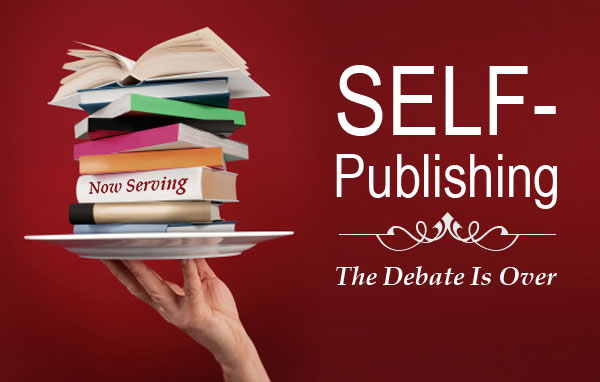Self-Publishing Business: Mastering Success in the Digital Age

In an era dominated by digital innovation and entrepreneurial spirit, self-publishing has emerged as a powerful gateway for authors to share their stories with the world. Aspiring writers, seasoned authors, and literary enthusiasts alike are drawn to the allure of creative independence, global reach, and the potential for substantial royalties. In this comprehensive guide, we delve into every facet of the self-publishing business, providing detailed insights, expert advice, and a step-by-step roadmap for your literary journey.
Decoding Self-Publishing

The Essence of Self-Publishing
Self-publishing is the process through which authors independently produce, publish, and distribute their literary works, bypassing traditional publishing houses. This approach offers unmatched creative freedom and control.
Decoding Self-Publishing
The Essence of Self-Publishing
In this digital age, self-publishing has emerged as a revolutionary pathway for authors to share their literary creations with the world. Unlike traditional publishing, which often involves a lengthy process of manuscript submission, review, and acceptance, self-publishing empowers authors with the autonomy to take their literary destiny into their own hands.
Creative Independence: Self-publishing offers authors creative autonomy. You have complete control over every aspect of your book, from its content and cover design to marketing strategies. This creative freedom allows you to shape your work according to your unique vision, unburdened by external influences.
Digital Era Accessibility: The advent of digital platforms and online marketplaces has transformed the publishing landscape. Self-publishing leverages these platforms, making it possible to reach a vast global audience. Your book can be accessed and enjoyed by readers around the world, eliminating geographical boundaries.
Speed to Publication: Self-publishing dramatically reduces the time it takes to bring your book to market. Traditional publishing can involve extensive waiting periods, but with self-publishing, your book can be available to readers within days or weeks of completion. This agility enables you to respond swiftly to current trends and reader demands.
Financial Benefits: Self-published authors often enjoy higher royalty rates compared to traditional publishing. This means a more substantial share of the revenue from book sales ends up in your pocket. You have the potential to earn more from your literary efforts.
Key Benefits of Self-Publishing
1. Creative Autonomy: Self-publishing grants you complete control over your work. You decide on the book's content, cover design, pricing, and marketing strategies. Your creative vision remains intact throughout the publishing process.
2. Global Visibility: Digital platforms and online marketplaces provide access to a vast global readership. Your book can be discovered and enjoyed by readers in different countries, breaking down geographical barriers.
3. Speed to Publication: Traditional publishing can involve prolonged waiting periods, from manuscript submission to book release. Self-publishing allows you to publish your book quickly, responding promptly to reader demand and market trends.
4. Higher Royalties: In traditional publishing, authors typically receive a lower percentage of royalties from book sales. In contrast, self-published authors often enjoy higher royalty rates, allowing for a more substantial income stream from their work.
The essence of self-publishing lies in empowering authors to bring their literary creations to life on their terms. It's a journey marked by independence, accessibility, speed, and financial rewards. In the chapters that follow, we'll explore the practical steps, strategies, and insider tips that will enable you to master the art of self-publishing.
Navigating the Self-Publishing Journey
1. Crafting Your Manuscript
The journey of self-publishing begins with the creation of your manuscript. This is the heart of your literary work, and its quality is paramount. Here's how to craft a manuscript that captivates readers:
Quality Writing: Start by producing high-quality content. Focus on storytelling, character development, and engaging prose. A well-crafted manuscript is the foundation of your book's success.
Editing Excellence: Editing is a crucial step in the writing process. Carefully review and revise your manuscript for grammar, punctuation, and clarity. Consider hiring a professional editor for a polished final product.
Proper Formatting: Pay attention to formatting guidelines. Different publishing platforms may have specific requirements for formatting your manuscript. Ensure it meets these standards for seamless publishing.
2. Cover Design Excellence
Your book's cover is its first impression, and it matters. A professionally designed cover can make the difference between a potential reader picking up your book or passing it by. Here's how to achieve cover design excellence:
Professional Designer: Consider hiring a professional cover designer. They have the expertise to create visually appealing and genre-appropriate covers that attract readers.
Visual Storytelling: Your cover should convey the essence of your book. It should offer a glimpse into the story's mood, genre, and key elements, sparking intrigue.
Testing and Feedback: Don't hesitate to seek feedback on your cover design from potential readers or fellow authors. Honest opinions can help you refine your cover for maximum impact.
3. ISBN and Copyright
Protecting your intellectual property and ensuring your book's legitimacy are essential aspects of self-publishing. Here's what you need to know:
ISBN (International Standard Book Number): An ISBN is a unique identifier for your book. It's required for most book distribution channels. You can obtain an ISBN from your country's ISBN agency or, in some cases, through your publishing platform.
Copyright Registration: While your work is automatically copyrighted upon creation, registering your copyright provides additional legal protection. Consider registering your book with the appropriate copyright office.
4. Choosing Self-Publishing Platforms
Selecting the right self-publishing platform is a pivotal decision. Each platform offers different features, distribution channels, and royalties. Here are some popular options:
Amazon Kindle Direct Publishing (KDP): Amazon's KDP platform is widely used by self-published authors. It provides access to the Kindle Store and a global audience.
Apple Books: Apple's platform is known for its user-friendly interface and distribution to Apple devices.
Barnes & Noble Press: This platform allows you to publish and distribute both e-books and print-on-demand books, reaching readers through Barnes & Noble.
Draft2Digital: A distributor, Draft2Digital, makes it easy to publish your book on multiple platforms, including Amazon, Apple, and more.
Smashwords: Smashwords offers distribution to various e-book retailers, making it a convenient choice for broad distribution.
When selecting a platform, consider factors like distribution channels, royalty rates, marketing tools, and ease of use. Your choice will impact how your book reaches readers and the royalties you earn.
5. Formatting and Layout
Proper formatting ensures your book looks professional and is easy to read. Here are key considerations:
E-Book and Print Formats: Depending on your chosen formats (e-book, paperback, hardcover), ensure your manuscript is correctly formatted for each. Different formats have distinct requirements.
Consistency: Maintain consistency in font choices, chapter headings, and layout throughout your book. Consistency enhances the reading experience.
Professional Formatting: While you can format your book yourself, consider hiring a professional formatter for a polished final product. Professional formatting ensures your book meets industry standards.
Navigating the self-publishing journey requires attention to detail and a commitment to producing high-quality work. By crafting a compelling manuscript, designing an enticing cover, securing ISBN and copyright protection, selecting the right publishing platform, and formatting your book professionally, you set the stage for a successful self-publishing venture. In the subsequent chapters, we'll explore marketing and promotion strategies, pricing, and sustaining your self-publishing business for long-term success.
Marketing and Promotion Strategies
As a self-published author, your literary masterpiece deserves a spotlight in the crowded world of books. Marketing and promotion are the keys to reaching your target audience and generating interest in your work. In this chapter, we'll explore effective strategies to ensure your book doesn't remain hidden on the digital bookshelves.
1. Building an Author Platform
Establishing a robust author platform is foundational to your marketing efforts. Your platform is your online presence and a direct connection to your readers. Here's how to build it:
Author Website: Create a professional website that showcases your books, provides author information, and offers a blog where you can share insights and updates.
Social Media Presence: Utilize social media platforms, such as Facebook, Twitter, Instagram, and LinkedIn, to engage with your audience. Consistent, authentic interaction fosters a loyal following.
Mailing List: Start building an email list from day one. Encourage readers to subscribe to receive updates, exclusive content, and special offers.
Blog and Content Creation: Regularly update your blog with relevant content. Share your writing journey, offer writing tips, and provide value to your readers.
2. Engaging with Social Media
Social media is a powerful tool for connecting with readers, fellow authors, and potential fans. Here's how to maximize its potential:
Choose the Right Platforms: Focus on the social media platforms where your target audience spends the most time. Each platform has its unique demographics and communication style.
Content Calendar: Develop a content calendar to plan and schedule posts. Consistency is key to maintaining an active presence.
Engagement and Interaction: Respond promptly to comments and messages. Engage with your audience by asking questions, running polls, and creating interactive content.
Visual Appeal: Use eye-catching visuals, such as book cover images, quotes from your work, and behind-the-scenes snapshots. Visual content tends to perform well on social media.
3. Crafting a Book Launch Strategy
A successful book launch is a culmination of careful planning and excitement generation. Here's how to craft a compelling launch strategy:
Pre-Release Buzz: Start generating excitement before your book's release date. Share teaser snippets, behind-the-scenes glimpses, and countdowns to build anticipation.
Cover Reveal: Create a memorable cover reveal event. Share your cover design with your audience, emphasizing its significance to your book.
Limited-Time Promotions: Consider offering limited-time promotions or discounts during the launch period to incentivize early purchases.
Leverage Amazon's KDP Select: If you publish through Amazon KDP, explore the benefits of KDP Select, such as Kindle Unlimited and Kindle Countdown Deals, to reach a broader audience.
4. Gathering Reviews and Testimonials
Book reviews and reader testimonials are invaluable assets for your book's credibility and visibility. Here's how to gather them:
Request Reviews: Reach out to book bloggers, reviewers, and readers in your genre and politely request reviews. Offer free advance review copies (ARCs) in exchange for honest feedback.
Reader Engagement: Cultivate a relationship with your readers. Encourage them to leave reviews on platforms like Amazon, Goodreads, and book-related websites.
Author Website Testimonials: Feature reader testimonials prominently on your author website. Positive feedback can sway potential readers.
5. Top Hashtags for Book Promotion
Harness the power of hashtags to increase the discoverability of your book on social media. Here are some popular book-related hashtags:
- #BookRecommendations
- #AmReading
- #BookBuzz
- #NewRelease
- #MustRead
- #AuthorLife
- #BookCommunity
- #IndieAuthors
- #[YourGenre]Reads (e.g., #MysteryReads, #RomanceReads)
These hashtags can help your posts reach a broader audience of book enthusiasts and potential readers.
Marketing and promotion are ongoing efforts that require dedication and adaptability. By building a strong author platform, engaging with social media, crafting a compelling book launch strategy, gathering reviews, and utilizing relevant hashtags, you'll be well-equipped to navigate the dynamic landscape of book promotion as a self-published author. In the next chapter, we'll explore strategies for pricing your book for optimal sales and royalties.
Maximizing Book Sales and Royalties
Publishing your book is just the beginning; maximizing book sales and royalties requires strategic planning and execution. In this chapter, we'll explore pricing strategies, multi-format publishing, and the advantages of enrolling in Amazon KDP Select.
1. Strategic Pricing
Determining the right price for your book is a critical decision that can impact its sales and profitability. Here's how to approach pricing strategically:
Market Research: Research the pricing of books in your genre. Analyze the price range of bestsellers and books with similar content. This will give you a benchmark.
Consider Formats: Different formats (e-book, paperback, hardcover) may warrant different price points. Keep in mind that e-books are generally priced lower than print versions.
Introductory Pricing: Consider launching your book with a special introductory price or a limited-time discount to encourage early sales.
Tiered Pricing: If you have multiple books or plan to release a series, consider tiered pricing. Offer the first book at a lower price point to attract readers to your series.
Experiment and Adjust: Don't be afraid to experiment with pricing. You can adjust your book's price based on its performance and reader feedback.
2. Multi-Format Publishing
To reach a wider audience and cater to different reading preferences, consider publishing your book in multiple formats:
E-Book: Publish your book in e-book format to target digital readers. E-books are accessible on various devices and often have lower production costs.
Paperback: Offer a paperback version of your book through print-on-demand (POD) services. POD allows for cost-effective printing, eliminating the need for large print runs.
Audiobook: Explore the audiobook format to tap into the growing audiobook market. Audiobooks are popular among commuters and listeners who prefer to experience books audibly.
Box Sets and Bundles: Create box sets or bundles of your books to incentivize readers to purchase multiple titles at once.
By providing your book in various formats, you make it accessible to a broader audience and increase your earning potential.
3. Exploring Amazon KDP Select
Amazon Kindle Direct Publishing (KDP) offers a program called KDP Select, which provides specific advantages for e-book authors. Here's how it works:
Kindle Unlimited (KU): Enrolling your e-book in KDP Select makes it available to Kindle Unlimited subscribers. Readers can borrow and read your book at no additional cost, earning you royalties based on pages read.
Kindle Countdown Deals: KDP Select allows you to run limited-time promotions called Kindle Countdown Deals. During these promotions, your e-book can be discounted, attracting more readers.
Free Promotions: You can offer your e-book for free for a limited time to generate buzz and garner reviews.
Increased Visibility: Enrolling in KDP Select may grant your book increased visibility on Amazon, as it becomes part of exclusive promotions and features.
Before enrolling, assess whether KDP Select aligns with your book's goals and whether the advantages, such as exposure to Kindle Unlimited subscribers, outweigh the exclusivity requirement.
Maximizing book sales and royalties requires a multifaceted approach. By strategically pricing your book, offering it in multiple formats, and exploring programs like Amazon KDP Select, you can optimize your book's earning potential. In the next chapter, we'll delve into sustaining your self-publishing business, ensuring long-term success in the dynamic world of self-publishing.
Conclusion
The self-publishing journey is a profound exploration of creativity, entrepreneurship, and literary achievement. This guide has illuminated every aspect of the self-publishing business, offering a roadmap to navigate the path to success. Embrace the world of self-publishing and embark on a literary adventure like no other. Master self-publishing for unparalleled literary success in the digital age.
Consider enrolling in professional courses to enhance your self-publishing skills. Websites like (my favourite) Mastering books Stefan James and many others online offer a variety of courses on self-publishing and book marketing, led by industry experts.




